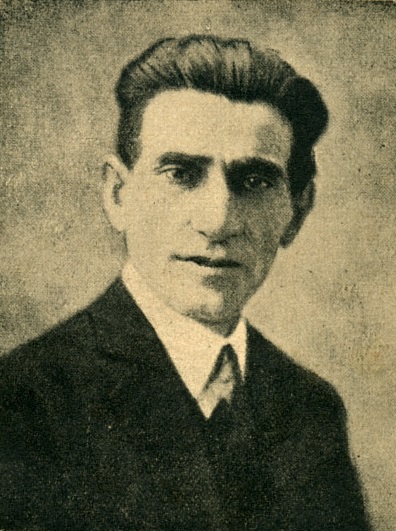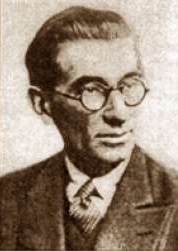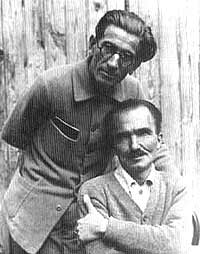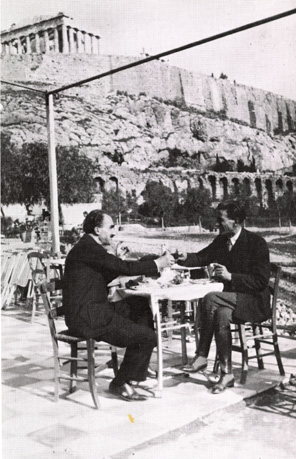<Back to Index>
- Biochemist Arne Wilhelm Kaurin Tiselius, 1902
- Writer Panait Istrati, 1884
- 1st Duke of Braganza Afonso I, 1377
PAGE SPONSOR


Panait Istrati (sometimes rendered as Panaït Istrati; August 10, 1884 – April 18, 1935) was a Romanian writer of French and Romanian expression, nicknamed The Maxim Gorky of the Balkans. Istrati was first noted for the depiction of one homosexual character in his work.
Born in Brăila, Istrati was the son of the laundress Joiţa Istrate and of a Greek smuggler from Kefalonia (whom Panait never met).
He studied in primary school for six years in Baldovineşti, after being held back twice. He then earned his living as an apprentice to a tavern keeper, then as a pastry cook and peddler. In the meantime, he was a prolific reader.
His first attempts at writing date from around 1907, when he started sending pieces to the socialist periodicals in Romania - debuting with the article Hotel Regina in România Muncitoare. Here, he later published his very first short stories - Mântuitorul ("The Redeemer"), Calul lui Bălan ("Bălan's Horse"), Familia noastră ("Our Family"), 1 Mai ("May Day"). He also contributed pieces to other leftist newspapers such as Dimineaţa, Adevărul, and Viaţa Socială.
In 1910, he was involved in organizing a strike action in Brăila. He went to Bucharest, Istanbul, Cairo, Naples, Paris (1913 – 1914), and Switzerland (where he settled for a while, trying to cure his tuberculosis); Istrati's travels were marked by two successive unhappy marriages, a brief return to Romania in 1915, when he tried to earn his living as a hog farmer, and long periods of vagabondage. While in the sanatorium, Istrati met Russian Jewish - Swiss Zionist writer Josué Jéhouda, who became his friend and French language tutor.
Living in misery, ill and depressed, he attempted suicide in 1921 on his way to Nice, but his life was rescued in time. Shortly before the attempt, he had written to the French writer he admired most, Romain Rolland, with whom he had tried to get in touch for long. Rolland received the letter through the Police, and immediately replied to this letter. In 1923 Istrati's story Kyra Kyralina (or Chira Chiralina) was published (with a preface by Rolland). It became the first in his Adrien Zograffi literary cycle. Rolland was fascinated with Istrati's adventurous life, urging him to write more, and publishing part of his works in the magazine he and Henri Barbusse owned, Clarté. The next major work by Istrati was his Codine novel.
Istrati shared the leftist ideals of Rolland, and, as much as his mentor, placed his hopes in the Bolshevik vision. In 1927 he visited the Soviet Union on the anniversary of the October Revolution, accompanied by Christian Rakovsky during the first stage of the journey (Rakovsky was Soviet ambassador to Paris, and by then already falling out of favor with Joseph Stalin). He travelled through large sections of the European part, witnessing celebrations in Moscow and Kiev. He was joined in Moscow by his future close friend, Nikos Kazantzakis; while in the city, Panait Istrati met Victor Serge and expressed his wish to become a citizen of the Soviet Union. He and Kazantzakis wrote Stalin a congratulatory letter that remained unanswered.
In 1928 - 29, after a tumultuous stay in Greece (where he was engaged in fights with the police and invited to leave the country), he went again to the Soviet Union. Through extended visits in more remote places such as the Moldavian ASSR (where he got in touch with his friend Ecaterina Arbore), Nizhny Novgorod, Baku and Batumi, Istrati learned the full truth of Joseph Stalin's communist dictatorship, out of which experience he wrote his famous book, The Confession of a Loser, the first in the succession of disenchantments expressed by intellectuals such as Arthur Koestler, André Gide and George Orwell. Istrati dealt with the mounting persecution of Old Bolsheviks and the gradual victimization of whole population groups. His views were also harshly made clear in two letters he sent to the GPU leadership in December 1928.
Thereafter, he suffered a crisis of conscience mainly due to being branded a "Trotskyist" or even a "Fascist"
by his former communist friends, the most violent of which proved to be
Henri Barbusse. Rolland had praised Istrati's letters to the GPU, but
he nonetheless chose to stay clear of the controversy. Istrati came
back to Romania ill and demoralised, was treated for tuberculosis in
Nice, then returned to Bucharest.
In fact, the political opinions Istrati expressed after his split with Bolshevism are rather ambiguous. He was still closely watched by the Romanian secret police (Siguranţa Statului), and he had written an article (dated April 8, 1933) in the French magazine Les Nouvelles Littéraires, aptly titled L'homme qui n'adhère à rien ("The man who will adhere to nothing").
At the same time, Istrati started publishing in Cruciada Românismului ("The Crusade of Romanianism"), the voice of a left leaning splinter group of the ultra nationalist Iron Guard. As such, Istrati became associated with the group's leader Mihai Stelescu, who had been elected as a member of Parliament for the Iron Guard in 1933 and whose dissidence was the reason for his brutal assassination by the Decemviri later in the same year; Istrati was himself assaulted several times by the Guard's squads.
Isolated and unprotected, Panait Istrati died at Filaret Sanatorium in Bucharest. He was buried in Bellu Cemetery.

